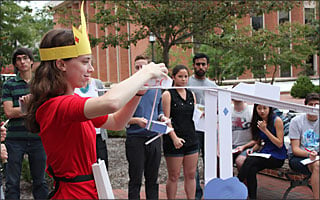“OK, are you guys ready?”
All eyes turned to the undergraduate student, who was launching a small, rickety cart down a foam-core ramp in front of Clark Hall. The apparatus was one of the first ‘pingpong ball transporter devices’ being showcased by freshmen in the Biomedical Engineering Modeling and Design course. And it worked — even if it took a few pokes to get the ball across the finish line.
The annual “BME Foam Core Challenge” is one of five team-based research projects in a semester-long course designed to give students a first taste of biomedical design. In this challenge, they were tasked with building two devices capable of transporting a pingpong ball three meters along a horizontal surface.
One team member was outfitted with a SHARD (Synchronous Heart Rate and Acceleration Recording Device) to measure and record his or her heart rate and acceleration data as the challenge was carried out.
This year marked the first time students designed, built, and tested their engineering solutions in the Department of Biomedical Engineering’s new state-of-the-art BME Design Studio. And the space, as designed, fostered even more student collaboration.
“This was definitely the year where we had the greatest exchange of information amongst teams and the greatest collaboration,” says course head lab manager Arda Ozilgen while watching students demonstrate their inventions.
Ozilgen credited the design studio’s layout, which encourages interaction not just between team members, but also between first-year, upper- and graduate-level students. The lab features wheeled tables and equipment that can be easily rearranged to better accommodate planning and prototype testing processes. It also boasts everything from rapid prototyping machines to sunlight-mimicking LED lighting and bins of Lego bricks. A large glass door separates the main studio from the BME Center for Bioengineering Innovation & Design master’s student space.
“It’s a really great free-thinking space,” says freshman Jose Solis after showing his pirate-themed pingpong transporter. “Everything is possible because there’s whiteboards on the walls, so it’s literally like everything you’re thinking goes straight from your head to the wall or on the piece of paper in front of you.”
The studio was funded by the Whiting School of Engineering and the university’s largest-ever Gateway Sciences Initiative grant from the Office of the Provost. Next year, it will be expanded to include a renovated student machine shop, wet lab, advanced prototyping space, and team meeting room with video conferencing to the Johns Hopkins University School of Medicine.
Design Studio Director Elizabeth Logsdon says the larger projects featured in this year’s Foam Core Challenge are a sign the new studio is providing students with space to experiment with bigger ideas.
“Instead of having to work in a dorm room, in an apartment, or squatting in the lab of one of our faculty members and using the corner of a bench to come up with something, students now have a place where everything they need is in one space,” says Logsdon.
— Sarah Richards

